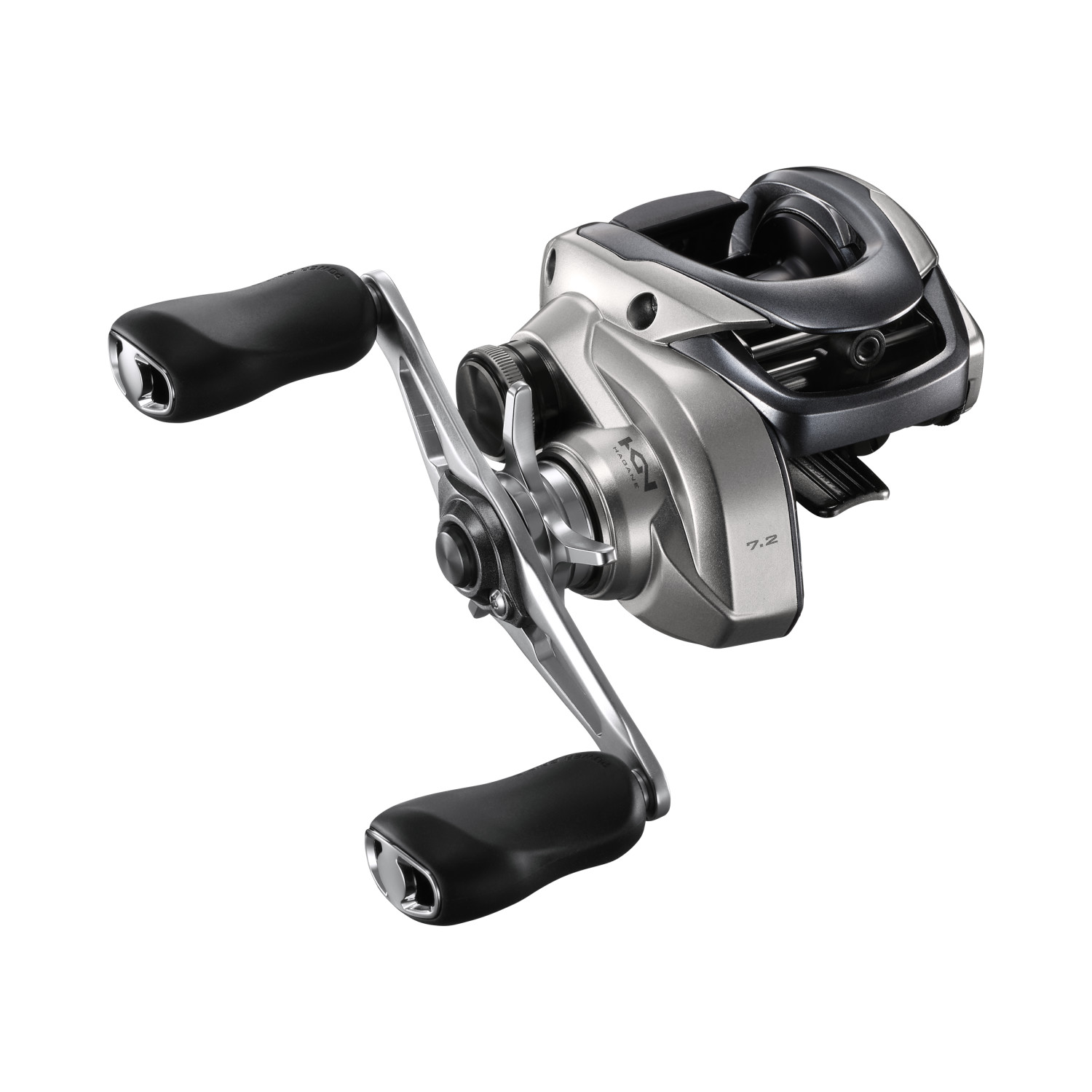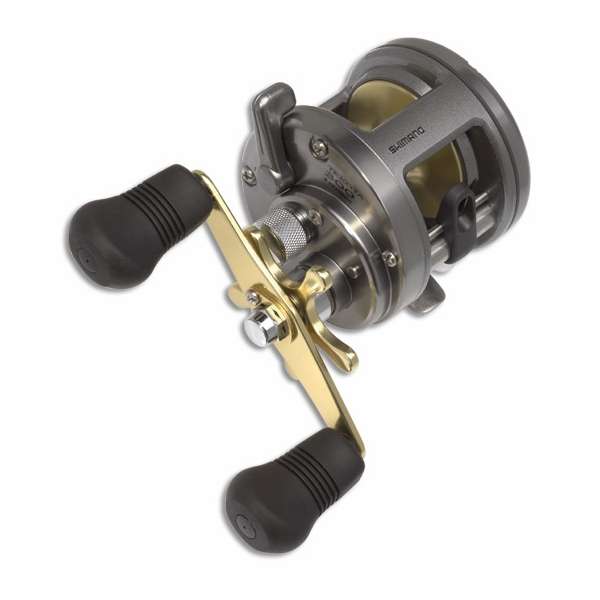Among the types of fishing reels available on the market today, the two that some anglers have the hardest time telling apart are baitcasting reels and conventional reels. For many anglers, understanding the difference between these reels is a point of confusion, largely because they look similar and have much in common. Long story short, baitcasting reels tend to be smaller and are designed for casting and retrieving, and conventional reels are larger and designed for fishing vertically from a boat, although there are a few exceptions.
Similarities
Let’s start by explaining the similarities between baitcasting reels and conventional reels. Both of these reels sit on top of fishing rods and feature a reel spool that has an axis perpendicular to the rod on which it is mounted, and the spool spins during casting or letting out line. This perpendicular alignment allows line to come off the spool in a smooth, straight line, without any line twist, as the spool itself spins to let out line. This is very different than a spinning reel, which has a spool with its axis in parallel alignment with the rod, and the fishing line resides upon a spool that is stationary during casting. Spinning reels tend to cause more line twist than baitcasting reels and conventional reels. However, spinning reels have their advantages too, such as being good for casting light lures and casting in windy conditions.
Both conventional and baitcasting reels have a crank style handle on the side of the reel, come in left hand or right hand retrieve models, and both can exhibit level wind features. A reel with a level wind has a moving line guide that the line runs through on the front of the reel. As line is reeled back into the reel, the line guide travels back and forth across the spool, ensuring the line lays down evenly across the spool and not all piled up in one section of the spool. Lastly, with both baitcasting reels and conventional reels, care must be taken to avoid the notorious backlash.
Baitcasting Reels
 Unlike conventional reels, all baitcasting reels have a level wind. More than anything else, baitcasting reels are engineered for their casting ability. A baitcasting reel is the right choice if you are planning to do any type of fishing that involves frequent casting, except for some saltwater fishing situations where small conventional reels are used for casting heavy lures like surface irons. In those cases, conventional reels may be the preferred choice because they have more cranking power and hold more line than a baitcasting reel.
Unlike conventional reels, all baitcasting reels have a level wind. More than anything else, baitcasting reels are engineered for their casting ability. A baitcasting reel is the right choice if you are planning to do any type of fishing that involves frequent casting, except for some saltwater fishing situations where small conventional reels are used for casting heavy lures like surface irons. In those cases, conventional reels may be the preferred choice because they have more cranking power and hold more line than a baitcasting reel.
Baitcasting reels allow for very controlled adjustment of how the spool will behave during a cast, usually with at least one type of adjustable cast control mechanism such as a centrifugal or magnetic braking system. With high quality bearing coupled to these cast control systems, this type of reel will support very smooth, accurate, and long-distance casts. There are even a few baitcasting reels on the market today with electronic braking systems. Even with the assistance of these cast control systems present, the angler must use their thumb to control the spool so that it does not cause a backlash during a cast.
Conventional Reels
 Conventional reels are designed for fishing vertically from a boat, trolling, or any situation where you are letting out line without casting. These reels can be much larger than baitcasting reels with greater line capacity and are designed to provide lots of power for reeling in fish back to the boat efficiently. They are built to put out lots of torque for reeling in big fish, with minimal stress on the gear. If you are going to fish for big fish like tuna and billfish, or salmon and halibut with heavy rigging, a conventional reel is going to get the job done.
Conventional reels are designed for fishing vertically from a boat, trolling, or any situation where you are letting out line without casting. These reels can be much larger than baitcasting reels with greater line capacity and are designed to provide lots of power for reeling in fish back to the boat efficiently. They are built to put out lots of torque for reeling in big fish, with minimal stress on the gear. If you are going to fish for big fish like tuna and billfish, or salmon and halibut with heavy rigging, a conventional reel is going to get the job done.
Some conventional reels even come in two-speed models, meaning the angler can switch between two different gear ratios. Two-speed conventional reels are best in some fishing situations, as the higher speeds let the angler fish lures at a faster pace, but lower gears allow them to put more torque on the fish.
Conventional reels will have either a star drag, or a lever drag. Conventional reels with a star drag are the most like baitcasting reels because they have a baitcasting reel style star-shaped drag control knob used to apply drag, as well as a little lever that functions the same way as a thumb bar on a baitcasting reel to put them into free spool. On the other hand, a conventional reel with a lever drag uses a lever to perform both functions as the lever can both apply drag and put the reel into free spool. The largest size conventional reels will always have a lever drag. With either type, care must be taken to prevent backlashes while they are in free spool. Always keeping a thumb on the spool is one way to prevent a free spool backlash.
Can a baitcasting reel ever be used like a conventional reel?
Yes, fishing from a boat without casting does not always mean you need a conventional reel. In some situations, a baitcasting reel can be used like a conventional reel, which is especially the case nowadays, since reel manufacturers started making very large baitcasting reels. These larger baitcasting reels, such as 300 or 400 size or bigger, have all the capabilities of a star drag conventional reel, and some anglers find them more comfortable to use. For example, when fishing from a boat in shallower water with lighter lures targeting not the biggest of fish species, a baitcasting reel can be used to vertically present the gear in the same way that would typically be done by a conventional reel. When using a baitcasting reel instead of a conventional reel, you then have the option of switching to a casting technique at any time with the same setup.
Final Thoughts
Baitcasting reels and conventional reels may look similar, but they are designed for fishing in very different ways. Whether a fishing situation calls for a baitcasting reel or conventional reel depends on the techniques and size of gear you are using. Do you plan on fishing vertically from a boat, or do you plan to be casting? Generally, if you are going to be casting, you want a baitcasting reel, and if you are dropping heavy gear from a boat, you want a conventional reel. However, in some cases you can use a large baitcasting reel to do the same things you can do with a small conventional reel, and there are some small conventional reels that can be casted like a baitcasting reel. Whichever one you choose, remember to keep your thumb on the spool to avoid backlashes, and as with any type of fishing reel, practice makes perfect.
